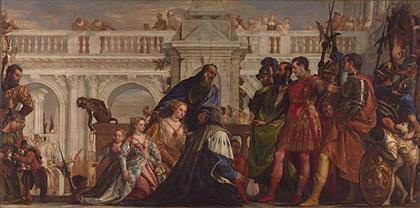
Veronese: ‘Family of Darius before Alexander’ (1565–7)
Veronese: Magnificence in Renaissance Venice
Veronese: Magnificence in Renaissance Venice On view at the National Gallery, London, from 19 March to 15 June 2014, ‘Veronese: Magnificence in Renaissance Venice’ is devoted to one of the most influential artists of the 16th century.]]>
Source: National Gallery, London
This exhibition of 50 of his works, many of which are travelling to London from across the globe, is the most significant collection of masterpieces by the artist ever to be displayed in the United Kingdom.
Paolo Caliari (1528–1588), known as Veronese, was one of the most renowned and sought-after artists working in Venice in the 16th century. His works adorned churches, patrician palaces, villas and public buildings throughout the Veneto region – and are inseparable from our idea of the opulence and grandeur of the Republic of Venice at that time.
‘Veronese: Magnificence in Renaissance Venice’ brings together works from every aspect of the artist’s oeuvre: portraits, altarpieces, allegorical decorations and mythological works. Paintings in this exhibition represent the very peak of the artist’s output at every stage of his career.
Important loans to the exhibition include works from churches and art galleries across Europe (Austria, France, Italy and Spain) and the USA. The exhibition displays many of Veronese’s most celebrated works, including ‘The Martyrdom of Saint George’ (about 1565) on loan from the church of San Giorgio in Braida, Verona, and ‘The Mystic Marriage of Saint Catherine’ (1565-70, Gallerie dell’Accademia, Venice). Neither of these great altarpieces has previously been seen in the United Kingdom and the exhibition will enable visitors to compare them with Veronese’s most accomplished secular painting of the same period, the magnificent ‘Family of Darius before Alexander’ (1565–7), which was among the first great works acquired by the National Gallery in mainland Europe.
Highlights of the exhibition include the display of three of the artist’s most beautiful portraits from the period of his arrival in Venice: ‘Portrait of a Gentleman’ (about 1555, Palazzo Pitti, Florence), the ‘Portrait of a Woman, known as the ‘Bella Nani” (about 1555–60, Musée du Louvre, Paris) and the ‘Portrait of a Gentleman’ (1560-65, The J. Paul Getty Museum, Los Angeles).
Related content
Strange Beauty: Masters of the German Renaissance at the National Gallery, London
Follow us on:


